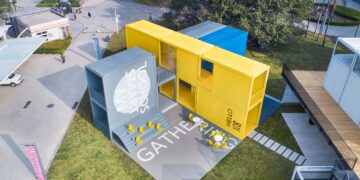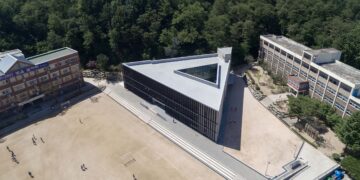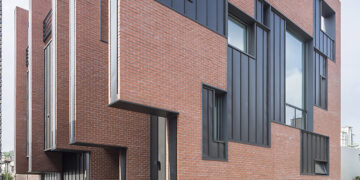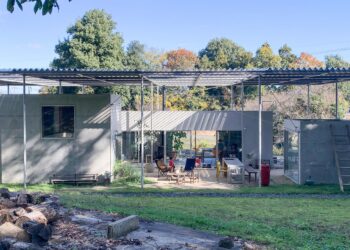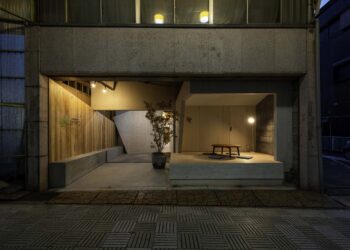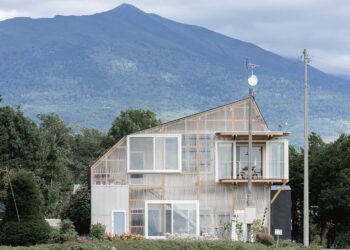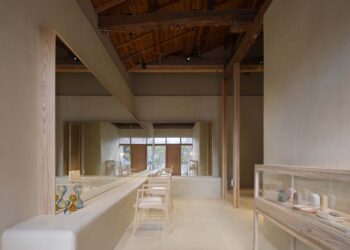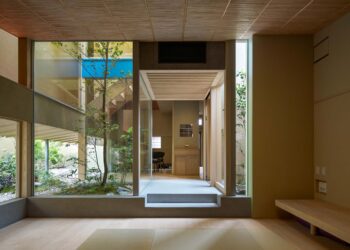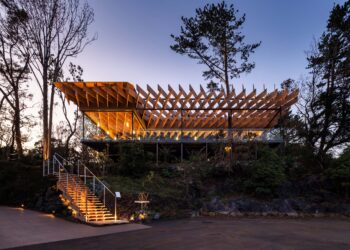An originally designed house opens up new opportunities for living
독창적으로 설계된 주택, 새로운 삶의 기회들을 열다
Tetsuo Yamaji Architects, Seiji Kamayachi Architects | 테츠오 야마지 아키텍츠, 세이지 가마야치 아키텍츠

This house has been created for a single man and his parents in the greater Tokyo / Kanto region of Japan. The client enjoys a close family relationship with his parents, who are still of working age, but busy lifestyles made spending family time together increasingly difficult. The house is intended to act as a gathering place for multiple generations of the same family – including the client’s children’s future families – almost like second home. The house was designed to give each of the occupants new opportunities to define their lifestyle, eschewing a stereotypical idea of a family home.
일본 도쿄 시부야구의 에비스에 한 미혼 남성과 그의 부모를 위한 집이 지어졌다. 건축주인 이 남성은, 아직 은퇴 전인 부모와 친밀한 가족관계를 유지하고 싶지만, 바쁜 생활 탓에 함께 시간을 보내기가 어려운 형편이라며, 훗날 가족을 이루게 되면 자식 세대를 포함해 부모님까지, 한 가족 내 여러 세대가 모이는 장소가 되어줄 집을 원했다. 건축가는 집에 대한 고정관념에서 벗어나 거주자들 각자가 자신의 생활방식을 유지하면서 함께 어울려 살 수 있는 집을 설계하기로 했다.



The architectural design process began with the concept of providing a home where it is possible to live, work and gather while catering to the needs of independent adult individuals. Firstly, the legally allowed maximum volume for the home was divided into five 1.7m x 2.2m modules, and a column and beam lattice structure was created using 100m x 100m steel H-beams. The architects then discussed with the family regarding where to insert the floors within the confines of the 33m² building area and the 12m high atrium – just like a three-dimensional game of Tetris.
The clients had certain requirements including: “The bathroom should be positioned with a fine view”; “the upstairs should be calmer and suitable for bedrooms”; and “the dining room should be downstairs for holding a party”. These two-dimensional thoughts grew into cross-sectional thinking. It was a fresh architectural design experience where the point of the conversation changed from the internal relationships between the rooms to the importance of the external relationships, such as the views and airiness of the interior. The process also provided an opportunity for the family to discuss what the future meant for them.




독립적인 성인의 요구를 충족시키는 동시에 생활, 일, 모임이 모두 가능한 가정을 만들겠다는 개념에서부터 설계를 시작했다. 일단 법적으로 허용되는 이 지역 주택의 최대 규모를 1.7×2.2m 크기의 조립식 모듈 다섯 개로 분할했고, 기둥과 격자 들보 구조물은 100×100m 강철 H빔을 이용해 제작했다. 그런 다음 건축가는 마치 3삼차원 테트리스 게임을 하듯, 33m2의 건물 면적과 12m 높이의 아트리움이라는 규제 안에서 어디에 모듈을 끼워 넣을 것인가를 건축주 가족과 함께 논의했다.
가족들은 몇 가지 사항을 제시했다. “욕실은 전망이 좋은 곳에 있어야 한다”, “위층은 조용해야 하며 침실이 배치되기에 적당해야 한다”, “식당은 잔치하기에 좋도록 아래층에 있어야 한다” 등이었다. 평면적인 이 생각들은 횡단면적 사고로 발전했다. 대화의 초점이 방들 간의 내부적 관계에서부터 전망이나 실내 통기성과 같은 중요한 외부적 관계로 바뀌어간, 매우 신선한 건축 설계 경험이었다. 이 과정에서 가족들은 자신들의 미래에 이 집이 어떤 의미인지 토론하는 기회가 되기도 했다.


The rooms, even those which are far from each other, seem close. A large, open view of the sky can be seen from the kitchen, which is situated at the very end of the basement. When looking down to the bedroom from the bathroom, the asphalt pavement in front of the house comes into view. The house is set up not to act as a “machine” where each room and corresponding family member performs a given “mission” logically, but instead offers opportunities where each family member can freely choose the usage, the climate, and different human interactions within a complex and rich environment.
방들은 멀리 뚝 떨어져 있는데도 가까운 것처럼 보인다. 맨 아래층 구석에 배치된 부엌에서도 넓게 탁 트인 하늘을 볼 수 있으며, 욕실에서 침실 쪽을 내려다보면 집 앞 아스팔트 보도가 시야에 들어온다. 이 집은 논리적으로 말해서 각 방과 그 방의 주인인 가족 구성원이 주어진 사명을 수행할 수 있게 ‘기계’ 노릇을 하지는 않지만, 가족 구성원 각자가 필요와 분위기, 구성원간의 상호작용을 복잡하고 풍부한 환경 속에서 자유롭게 선택할 수 있는 기회가 되어준다.



Project: House in Ebisu / Location: Ebisu, Japan / Architects: Tetsuo Yamaji Architects, Seiji Kamayachi Architects / Structural engineer: Shimizu Structural Engineers Co.,Ltd. / Site area: 64.41m² / Bldg. area: 31.32m² / Gross floor area: 98.90m² / Completion: 2018.6 / Photograph: ©Kenta Hasegawa






